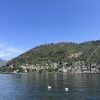If you are to give me a chance to talk about the old city of Tripoli, I probably won’t shut up. I will talk and talk because it is a place that holds a special place in my heart and even though it has been in Tripoli for ages; but I consider it a precious discovery and my getaway when I want to go back in time. I have said it before; the Old City is actually a city inside of a city and you get to experience the best of both worlds.
The Old City of Tripoli is located downtown. The first thing you will notice when you are at the corniche road which is the entrance to the old city is Marcus Arch. It is one of Tripoli’s most famous landmarks and it is still present to witness the changes in Tripoli and also, to remind us of the history of this enormous figure. Tripoli is a historical city not like Libda and Sabrata which are considered to be two archaeological cities.
Marcus Arch is considered to be the only Romanian ruin which is still fighting time in Bab Al-Bahir area in Tripoli. It was built in the Second century AD. The arch was built in order to honors both emperors, Marcus Aurelius and Locus Versus in 163 when they both shared rule after the death of emperor Antonius Piuson March 7th, 161 until the death of Locus in the winter of 169.
Caius Calpurnius Silus fully funded the construction of the arch and he was one of the cities richest men. He held an administrative and religious position at that time. The arch has four openings and this type of arches is called “Tetrabell”. The name’s origin is from one of the old gods “Janus” which was located in the Romanian pantheon. The first arch to be built from this type was in Emperor Nirva’s era (96 – 98).
The importance of Marcus Arch lies within the urban design of the old city under the Italians rule. It was built in a central location for transportation. It is located in the crossroads of two main roads “Cardo and Decumanus”. There is a possibility that it was located in the centre of Form square “Public Square”. The base of the arch is 3.5 meters above the sea surface. It is constructed with Greece type of tiles.
It was designed in order for the north-eastern and southwestern openings to be wider than the other two openings. This indicates that the road from the port was the most important and most crowded. The entrances of the arch are basically half circular collars. They are cantered with collar key and the sides are stuffed with giant tile lumps.
In addition, the lower parts of the arch were buried down until 1912. The management of the archaeology department began the excavation process between 1918 and 1912. On 1937, both architects, Giacomo Caputo, and Di Fausto did the repairing work. The Italian authorities removed close buildings surrounding the arch in order to set a space for it.
Here we are now, in 2019, and the arch is an example of the richness of the Libyan history. In order for us to understand our present, we must first understand our past. In this piece, I hope I was able to transfer to you part of the story. Hopefully, I will share with you the rest soon.









